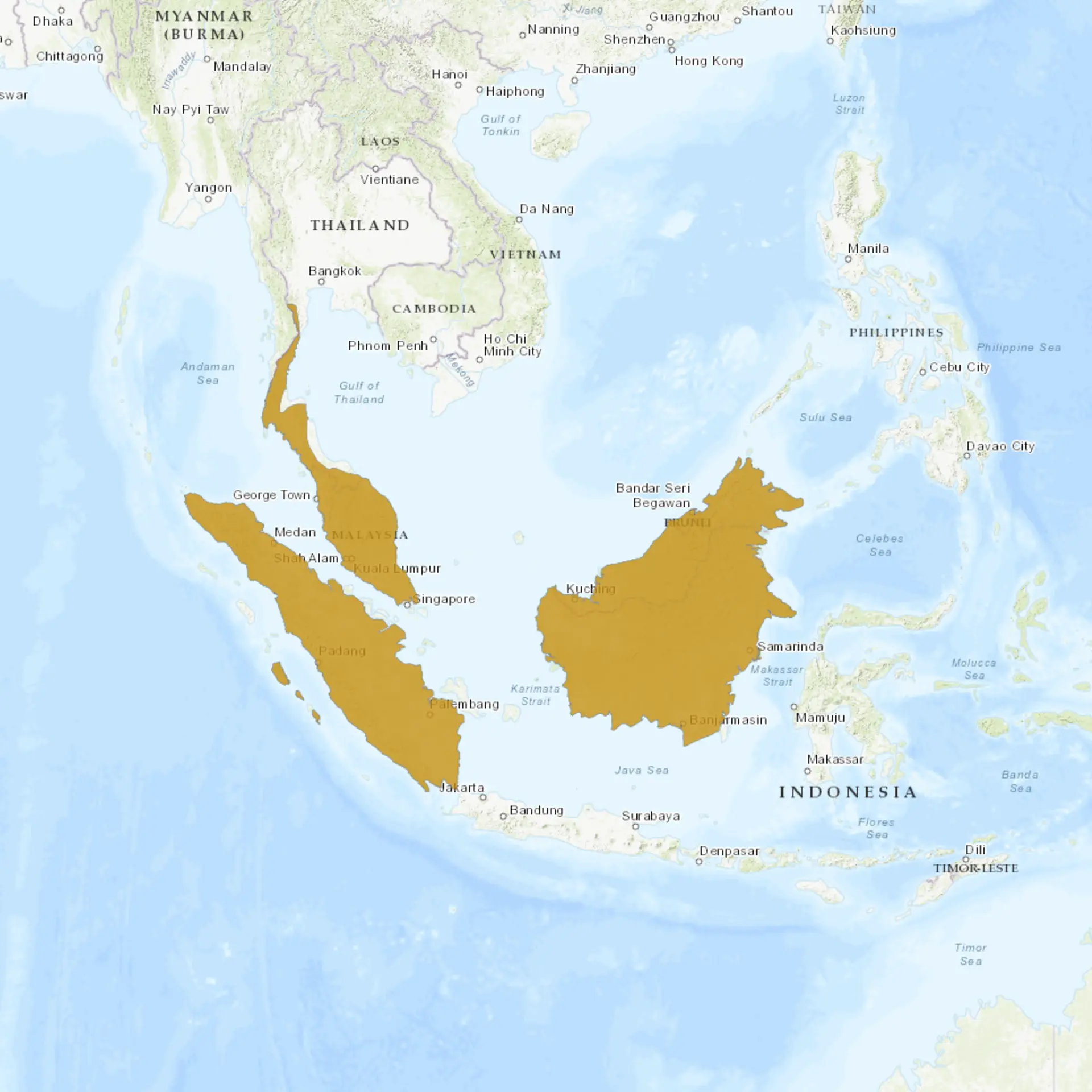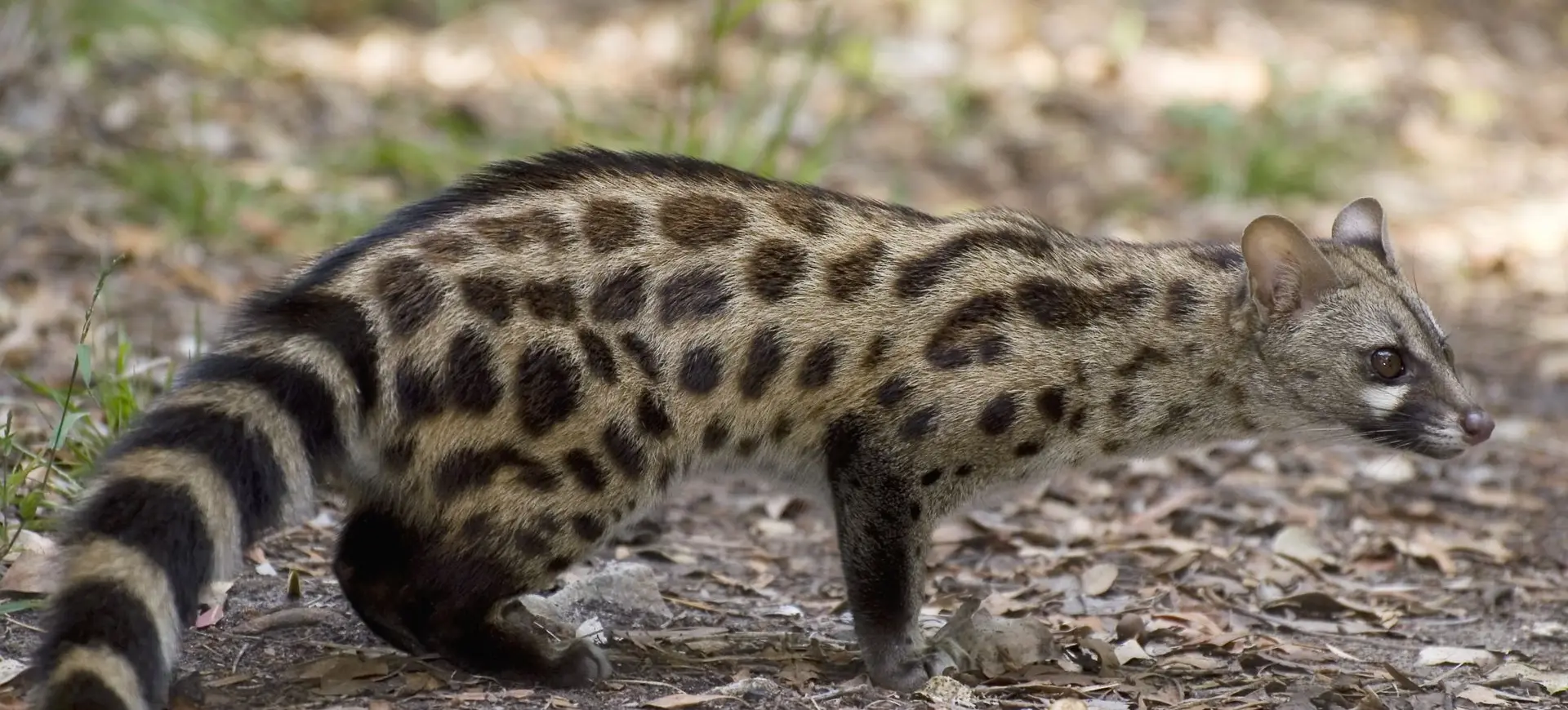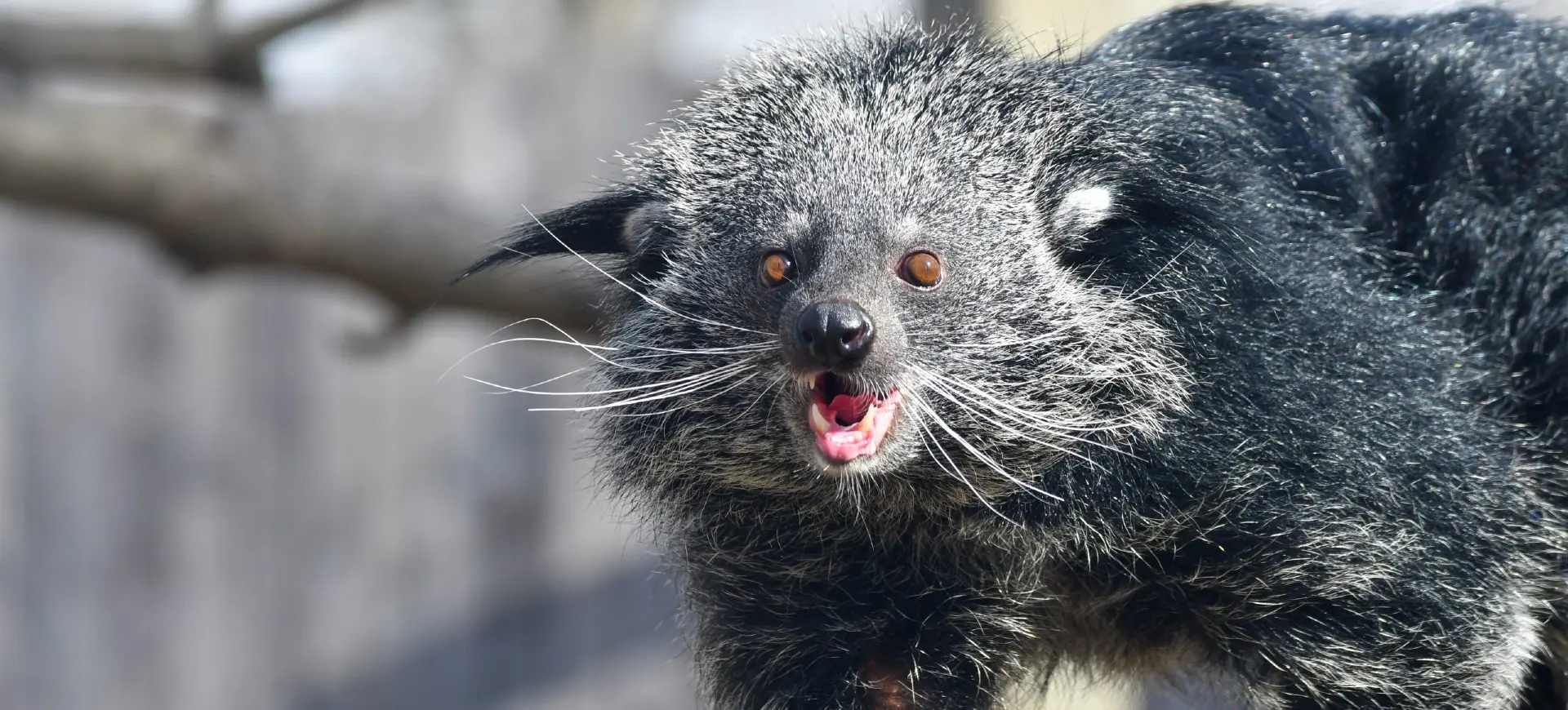Overview
The Banded Palm Civet, scientifically known as Hemigalus derbyanus, is a distinctive small carnivore found in the tropical forests of Southeast Asia. This species is notable for its slender body, short legs, and unique dark bands that run across its back and tail, giving it its common name. The civet’s diet primarily consists of small vertebrates, insects, and sometimes fruits, showcasing its opportunistic feeding habits. Active mainly at night, the Banded Palm Civet is a solitary and elusive animal, making it challenging to observe in the wild.
The Banded Palm Civet’s habitat includes a variety of forest types, from lowland rainforests to montane regions, demonstrating its adaptability to different forest environments. Despite this adaptability, the species is facing threats from habitat loss due to logging, agricultural expansion, and human settlement. Conservation efforts are crucial to ensure the survival of this unique species, focusing on habitat protection and understanding its ecological role within its environment.
The conservation status of the Banded Palm Civet is of concern, as its populations are believed to be declining across its range. The species serves as an important indicator of forest health and biodiversity. Efforts to study and conserve the Banded Palm Civet are hindered by its secretive nature and the challenging terrain of its habitat. Protecting the remaining forested areas where the civet lives is essential for its conservation and preserving the broader biodiversity of Southeast Asia.
Taxonomy
Kingdom
Phylum
Class
Order
Family
Genus
Species
Type
Current distribution:
The Banded Palm Civet’s range spans the tropical rainforests of Southeast Asia, with populations found in Myanmar, Thailand, Peninsular Malaysia, and the islands of Sumatra and Borneo. It is generally restricted to forested areas and avoids open landscapes, limiting its distribution to regions with adequate canopy cover. The species has also been recorded in some secondary forests and degraded habitats, although its abundance is lower in these areas compared to primary forests.
Deforestation and habitat fragmentation have led to localized declines in its population, particularly in regions with extensive logging or agricultural expansion. The species is most commonly found in protected areas, including national parks and wildlife reserves, where forest ecosystems are preserved. Despite being elusive, occasional sightings and camera trap data confirm its presence across much of its historical range. Continued habitat loss, however, threatens its long-term survival in the wild.
Physical Description:
The Banded Palm Civet is distinguished by its sleek, slender body, which measures approximately 41 to 53 centimeters in length, complemented by a tail of similar length. Its grayish-brown coat has five to six dark bands running across its back and additional bands on the tail, which are key identification features. The civet’s face is characterized by a pointed snout and large, expressive eyes adapted for its nocturnal lifestyle. Its small, rounded ears and sharp claws further aid in its survival within the dense forests it calls home.
Sexual dimorphism in the Banded Palm Civet is minimal, with males and females appearing similar in size and coloration. The civet’s physical adaptations, including its agile body and strong climbing abilities, enable it to effectively navigate the complex canopy of tropical forests. This species is also known for its quiet demeanor and the ability to move stealthily through the underbrush, making it a proficient hunter and difficult to detect.

Lifespan: Wild: ~12 Years || Captivity: ~18 Years

Weight: Male: 6.6-8.8 lbs (3-4 kg || Female: 4.4-6.6 lbs (2-3 kg)

Length: Male & Female: 16.1-20.9 in (41-53 cm)

Top Speed: 14 mph (22.5 km/h)
Characteristic:
Native Habitat:
The Banded Palm Civet is native to Southeast Asia, covering parts of Thailand, Malaysia, Indonesia, and Brunei. It prefers dense tropical forests, lowland and montane, and swamp forests, highlighting its adaptability to various forested environments. The species’ ability to inhabit a range of forest types is crucial for its survival, providing ample cover and food resources.
Despite its adaptability, deforestation and habitat fragmentation threaten the Banded Palm Civet’s habitat. The conservation of its natural habitat is vital for the species’ survival, necessitating efforts to protect and restore forested areas within its range. Research into the civet’s habitat preferences and range is essential for informed conservation planning and action.
Climate Zones:
Biomes:
Biogeographical Realms:
Continents:
Diet:
Diet & Feeding Habits:
The Banded Palm Civet’s diet is varied, consisting of small mammals, insects, and occasionally fruit, making it an omnivore leaning towards carnivory. Its foraging behavior is primarily nocturnal, utilizing the cover of darkness to hunt and search for food. The civet’s sharp teeth and claws are well-adapted for catching and consuming a variety of prey, from small rodents to insects. This dietary flexibility allows the Banded Palm Civet to thrive in various forest habitats, adjusting its diet based on availability and season.
In terms of ecological impact, the Banded Palm Civet controls the populations of its prey, contributing to the balance of its ecosystem. Its consumption of fruit also makes it a potential seed disperser, although this aspect of its ecology is less understood. The civet’s feeding habits reflect its adaptability and the importance of a diverse diet for survival in the wild.
Mating Behavior:
Mating Description:
Little is known about the specific mating behaviors of the Banded Palm Civet due to its secretive nature and nocturnal habits. The species is believed to be polygynous, with males potentially mating with multiple females during the breeding season. The timing of the mating season is not well documented, but environmental factors and food availability likely influence it. Gestation is thought to last approximately two to three months, culminating in the birth of one to three offspring.
The young are cared for in a den, usually well-hidden in the forest undergrowth or tree hollows, protecting from predators. Maternal care is essential during the early life stages, with the offspring depending on the mother for nourishment and protection. The development of the young is a critical period during which they learn the necessary skills for survival in the dense forest environment.
Reproduction Season:
Birth Type:
Pregnancy Duration:
Female Name:
Male Name:
Baby Name:
Social Structure Description:
The Banded Palm Civet is a solitary animal. Individuals typically maintain their own territories except during mating season. These territories are marked with scent markings, which serve to communicate with other civets and establish boundaries. The solitary nature of the Banded Palm Civet reduces competition for resources within its habitat but makes the species vulnerable to the impacts of habitat fragmentation.
Social interactions among Banded Palm Civets are not well understood but are thought to be limited to mating and mother-offspring relationships. Juveniles’ ability to survive and thrive depends on learning essential survival skills from their mothers, including hunting and territory navigation.
Groups:
Conservation Status:
Population Trend:
The Banded Palm Civet population is considered fragmented and under threat primarily due to habitat destruction and fragmentation. The species’ reliance on dense forest habitats means that logging, agricultural expansion, and human encroachment pose significant risks. Isolated populations are particularly vulnerable, as they have limited genetic diversity and reduced resilience to environmental changes and disease.
Efforts to understand the distribution and density of Banded Palm Civet populations are hampered by the species’ nocturnal and secretive behavior. Camera trapping and field surveys are crucial tools for conservationists aiming to gather data on this elusive species. Understanding population trends is essential for developing effective conservation strategies and monitoring the impact of habitat protection efforts.
Population Threats:
The primary threat to the Banded Palm Civet is habitat loss due to deforestation for timber, palm oil plantations, and agricultural development. This loss reduces the available territory for the civets and impacts the abundance and diversity of their prey. Habitat fragmentation further isolates populations, limiting their movement and reducing genetic diversity. In addition to habitat destruction, the Banded Palm Civet faces threats from hunting and roadkill in areas where roads intersect their habitats.
Climate change poses an additional threat, potentially altering the ecosystems the civets depend on for survival. The cumulative impact of these threats necessitates urgent conservation action to protect and restore the Banded Palm Civet’s natural habitat.
Conservation Efforts:
Conservation efforts for the Banded Palm Civet include habitat protection and restoration, focusing on maintaining and reconnecting fragmented forest areas. Protected areas play a critical role in conserving suitable habitats for the civets, but effective management and enforcement are essential to ensure their effectiveness. Raising awareness among local communities about the Banded Palm Civet’s importance and role in the ecosystem is also crucial for reducing hunting and habitat destruction.
Research into the Banded Palm Civet’s ecology, behavior, and population dynamics is vital for informing conservation strategies. Conservation organizations and researchers are working to improve understanding of the species needs and threats. International collaboration is necessary to address the cross-border challenges of habitat conservation in the Southeast Asian region.
Additional Resources:
Fun Facts
- The Banded Palm Civet is one of the few civet species whose unique dorsal banding allows it to be identified.
- Despite being classified as carnivores, Banded Palm Civets have a diverse diet that includes significant amounts of fruit, making them important seed dispersers in their ecosystem.
- They are skilled climbers but spend considerable time foraging on the ground.
- The Banded Palm Civet’s whiskers are highly sensitive, aiding navigation and hunting in the dark.
- Unlike some civet species, the Banded Palm Civet does not produce civetone, a compound used in perfumery.
- Their ability to remain hidden and silent makes them difficult to spot in the wild, contributing to their mysterious nature.
- Banded Palm Civets have a wide vocal range, including hisses, growls, and purrs, although humans rarely hear these sounds.
- Conservation efforts for the Banded Palm Civet also benefit other species that share their habitat, highlighting the importance of ecosystem-based conservation.
- The Banded Palm Civet’s distinctive appearance has made it a subject of interest in wildlife photography and conservation circles.
- Despite their elusive nature, Banded Palm Civets play a crucial role in their ecosystems as predators and seed dispersers.









